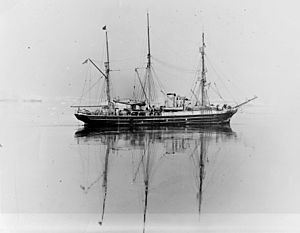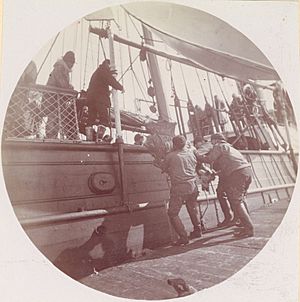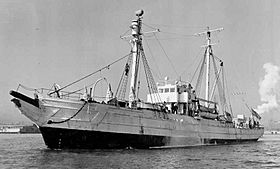USS Bear facts for kids

USS Bear (AG-29) in Antarctica, 1939
|
|
| History | |
|---|---|
| Name | SS Bear |
| Owner |
|
| Port of registry | St. John's, Newfoundland and Labrador |
| Builder | Alexander Stephen & Sons Ltd. [Dundee], Scotland |
| Launched | 1874 |
| Identification | Official Number: 66840 |
| Fate | Sold to U.S. government in 1884 |
| Name |
|
| Commissioned | 1885 |
| Decommissioned | 1944 |
| In service | 1884–1929, 1939–1944 |
| Out of service | 1926–1938 (museum ship); 1944–1948 (laid up) |
| Fate | Sold to Canadian owners for sealing in 1948 |
| Notes | Wireless call sign for USRC Bear was "RCB". |
| Name | SS Arctic Bear |
| Owner | Shaw Steamship Line |
| Port of registry | Halifax, Nova Scotia |
| Out of service | 1948–1961 (protracted refits); 1962 (restaurant conversion) |
| Fate | Sank in the Atlantic, 19 March 1963, under tow |
| General characteristics | |
| Type | Ice-strengthened auxiliary steamer |
| Displacement | 703 tons |
| Length | 198.5 ft (60.5 m) |
| Beam | 30 ft (9.1 m) |
| Draft | 18.8 ft (5.7 m) |
| Propulsion | 300 ihp (220 kW) compound steam engine, 1 screw |
| Range | Limited by water and provisions |
| Complement | 51 |
| Aircraft carried | Carried Barkley-Grow seaplane on Byrd Expedition III |
The USS Bear was a very strong ship, built with thick wooden sides. It used both steam power and sails. This ship had a long and exciting life, working in many cold and icy places. It was like an early version of today's icebreakers. The United States Coast Guard even calls Bear "probably the most famous ship in the history of the Coast Guard."
Bear was built in Scotland in 1874 to help with seal hunting. For ten years, it operated out of Newfoundland. In the mid-1880s, it joined a search party for the missing Greely Expedition. Later, Captain Michael A. Healy of the United States Revenue Cutter Service (which is now part of the United States Coast Guard) commanded Bear. They patrolled the huge 20,000-mile coastline of Alaska. The ship even helped out after the big 1906 San Francisco earthquake.
Bear also took part in Admiral Richard E. Byrd's second trip to Antarctica. In 1941, it went back to Antarctica to help Americans leave as World War II was starting. During the war, it patrolled the coast of Greenland for the United States Navy. In between these important missions, Bear was a museum ship in Oakland, California. It even appeared in a 1930 movie called The Sea-Wolf, based on a book by Jack London.
After World War II, Bear went back to being a sealing ship. But in 1963, when it was 89 years old, something sad happened. While being pulled to Philadelphia to become a floating restaurant, Bear sank in the Atlantic Ocean. This happened about 100 miles south of Cape Sable Island, Nova Scotia.
Contents
Building a Tough Ship for Seals
Bear was built in 1874 in Dundee, Scotland. It was specially made for seal hunting near St. John's, Newfoundland. At the time, Bear was the best sealing ship around. It was the first of a new kind of powerful sealing vessel.
The ship was built very strong, with wooden planks that were 6 inches (15 cm) thick. It had sails like a barquentine (a type of sailing ship), but its main power came from a steam engine. This engine was designed to break through thick ice to reach seal herds. When Bear arrived in St. John's, many smaller sailing ships were used for sealing. But new steamships like Bear changed the seal hunting industry. Large companies in St. John's started owning these big, expensive steamships.
Bear was first owned by a Scottish company called W. Grieve and Sons. In 1880, R. Steele Junior bought it. Bear spent ten years hunting seals from St. John's. In 1884, the Steeles sent Bear back to Scotland for some repairs and upgrades.
Serving the U.S. Government
The strong wooden hulls of Newfoundland sealing ships were perfect for exploring the Arctic. So, in 1884, after its repairs, the U.S. government bought Bear. Under Commander Winfield Scott Schley, Bear helped search for the missing Lady Franklin Bay Expedition. They found seven survivors at Cape Sabine.
Bear then became a revenue cutter for the U.S. government. It served in the United States Revenue Cutter Service from 1885 to 1915. After that, it became a cutter in the United States Coast Guard from 1915 to 1926.
Every May, from 1885 to 1926, Bear would leave Oakland, California. It sailed north to Alaska for a five-month season. This was called the Bering Sea Patrol. During these patrols, Bear traveled 10,000 nautical miles (about 11,500 miles). Its jobs included:
- Looking for people illegally hunting seals.
- Rescuing whalers whose ships were wrecked.
- Stopping illegal trading with Alaska Natives.
- Carrying reindeer from Siberia to Alaska.
- Acting as a floating courthouse to solve legal problems.
The U.S. Department of the Treasury gave Bear special powers. It could arrest people and take their belongings if they were poachers, smugglers, or illegal traders. It also counted people and ships, recorded information about geology and stars, noted tides, and escorted whaling ships.
Captain Michael Healy's Adventures
One of Bear's famous captains was Michael A. Healy, also known as "Hell Roaring Mike." Many whalers and native Eskimos saw him as a hero. He even bought Siberian reindeer with his own money to help starving native people start new herds in Alaska. Captain Healy was the first African-American officer to be officially recognized in U.S. history.
During Captain Healy's and Bear's Bering Sea Patrol in 1891, they did many important things:
- They found witnesses for a murder trial.
- They transported reindeer.
- They sailed the Alaskan governor.
- They carried a U.S. geographical survey team.
- They delivered wood and supplies to build schools in faraway places.
- They took teachers to their remote jobs.
- They delivered mail for the U.S. Post Office Department.
- They made sure federal laws were followed.
- They gave medical help to native people.
- They performed search and rescue missions.
During one of its yearly trips back to San Francisco, Bear helped with rescue efforts after the big 1906 San Francisco earthquake. On January 28, 1915, the Revenue Cutter Service joined with the United States Life-Saving Service to form the United States Coast Guard. Because of this, the ship was renamed USCGC Bear.
A Movie Star and Explorer
In 1926, Bear made its last patrol to Alaska. When it returned to Oakland that November, a new cutter, USCGC Northland, took its place. Bear was then given to the city of Oakland to become a large museum ship with its barquentine sails.
In 1930, Bear became a movie star! It played the sealing ship Macedonia in the film version of Jack London's The Sea-Wolf.
In 1932, Rear Admiral Richard E. Byrd bought Bear of Oakland for $1,050. He needed a ship to replace his old one, City of New York. Byrd used Bear for his Second Byrd Expedition to Antarctica. Another ship, Jacob Ruppert, joined Bear on this trip. After the expedition, Admiral Byrd let the Navy use Bear for just one dollar a year for his third expedition.
Helping in Antarctica
On September 11, 1939, Bear was officially brought back into service by the U.S. Navy. It was renamed USS Bear (AG-29). It served during the 1939–1941 United States Antarctic Service Expedition, which was also led by Rear Admiral Richard E. Byrd. Bear even carried a seaplane on board! Lieutenant Commander Richard H. Cruzen was the captain of Bear during this expedition.
In early 1941, USS Bear helped evacuate the people from the Antarctic Expedition. This was important because tensions were rising around the world before America joined World War II. Bear arrived at the Mikkelsen Islands on March 16, 1941. Its crew helped build a good airstrip to get people and equipment out of the expedition base.
World War II Service
From 1941 to 1944, Bear served in the Northeast Atlantic as part of the Greenland Patrol. Its sails were removed, and it became a fully motorized ship. On September 12, 1941, the USCGC Northland captured a German-controlled Norwegian sealing ship called Buskø. This ship was being used to supply secret weather stations. Bear then towed this captured ship to Boston.
When newer ships became available, Bear was taken out of service on May 17, 1944. It stayed in Boston until the end of the war.
Bear was special because it was the oldest U.S. Navy ship to be sent outside the United States during World War II. It was also one of the last ships with sails to serve in a war. Plus, it was one of the very few U.S. Navy ships that served during the Spanish–American War and both World War I and World War II. (Other old sailing ships like USS Constitution and USS Constellation were also active during World War II, but they didn't leave port.)
Final Journey and Discovery
In 1948, Frank M. Shaw of Halifax, Nova Scotia bought Bear from the U.S. government for $5,199. Shaw wanted to use the ship for sealing again. It was renamed Arctic Bear. However, fixing it up for sealing was very expensive. Also, the large-scale seal hunt in Newfoundland was declining. So, the ship was often left unused in Halifax Harbour and Dartmouth.
In the early 1960s, people thought about restoring Bear to be a museum ship. The cities of Dartmouth, Oakland, and the San Francisco Maritime National Historical Park were interested. But the cost to buy it from Shaw Steamships and the huge amount of money needed for repairs stopped these plans.
In 1962, Alfred Johnston of Philadelphia bought it. He wanted to turn it into a floating seafood restaurant. Repairs were made in Mahone Bay, Nova Scotia, including carving a new bear figurehead for the front of the ship.
In 1963, while being towed by the tugboat Irving Birch to Philadelphia, Bear sank. This happened about 100 nautical miles (about 115 miles) south of Cape Sable Island, Nova Scotia, on March 19, 1963. A strong storm hit, and the tow line broke. The mast fell and poked a hole in the hull, causing the ship to sink. The two people on board were rescued by the Irving Birch.
In October 2021, a shipwreck found two years earlier was confirmed to be Bear. It was found about 260 miles east of Boston.
Bear's Lasting Legacy
Bear had an amazing career that lasted for 89 years! It spent 47 years serving the United States Revenue Cutter Service, Coast Guard, and Navy. It was one of only a few ships to have worked in both the Arctic and Antarctic regions. It's also one of the very few U.S. Armed Forces ships to be active during the Spanish-American War, World War I, and World War II.
There is a large, detailed model of Bear on display at the Stockton Center for International Law. This is part of the United States Naval War College in Newport, Rhode Island.
The figurehead (the carved decoration on the front) from Bear is now in the collection at the Mariners' Museum and Park in Newport News, Virginia.
The mascot of the United States Coast Guard Academy is Objee the bear. This mascot was inspired by the Coast Guard Cutter Bear. The sports teams at the Coast Guard Academy are even called the Coast Guard Bears.
Awards and Honors
- Spanish Campaign Medal
- World War I Victory Medal with "ASIATIC" clasp
- Second Byrd Antarctic Expedition Medal
- United States Antarctic Expedition Medal
- American Defense Service Medal with "A" device
- American Campaign Medal
- European-African-Middle Eastern Campaign Medal
- World War II Victory Medal
- Coast Guard Arctic Service Medal



